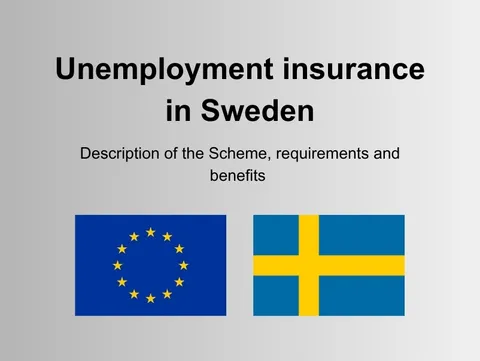EU
Sweden
Unemployment
Insurance
Unemployment Insurance in EU->Sweden->Changes in 2025
Changes to swedish unemployment insurance in 2025
The government's reform of unemployment insurance means that the right to unemployment benefit will be based on income instead of time worked.
The income-based unemployment insurance will be introduced on 1 October 2025.
Are you interested to see how the rules are until 1 October 2025, you can have a look at our information about unemployment insurance in Sweden.
What changes?
The basic prerequisites (free to work in Sweden, active look for job and registered with the employment service) for the right to unemployment compensation will essentially be the same as today.
A transition to income-based unemployment insurance affects primarily the qualification condition, the length of the compensation period and the size of unemployment compensation.
There will from 1 October 2025 no longer be distinguished between the basic unemployment insurance (grundförsäkring) and the earnings-related voluntary unemployment insurance trough membership of an Unemployment Insurance Fund ("A-kassa").
New common rules for calculation and reduction of unemployment compensation will be introduced, and the basic and voluntary insurance will both be based on income.
The group of unemployed persons who today only will get the flat-rate basic unemployment benefit (this is people who are not member of an A-kassa or who have not been member for the required period) will from October 2025 get the lowest compensation introduced in the new rules - which is 50% of previous income. To get the higher compensation levels it requires membership of an A-kassa for at least 6 months (see below).
The income requirement
To be entitled to unemployment benefit, the applicant must have fulfilled an income condition. This is a prerequisite regardless of whether the applicant has been an employee or an self-employed.
The income that has been used for assessing whether the income condition is met will also have significance for the length of the benefit period and the size of the benefit.
You can meet the income requirement according to either the main rule or the alternative rule.
Main rule
During the last 12 months, you must have had a total income of at least SEK 120,000 and a monthly income of at least SEK 11,000 for at least four months.
Alternative rule
If an applicant does not meet the minimum total income requirement from gainful employment under the main rule, the income condition will still be met if the applicant has had the minimum monthly income from gainful employment required under the main rule (SEK 11,000/month in 2025) for at least four consecutive months within the last 12 months.
An applicant should be able to receive unemployment benefit according to the alternative rule in two unemployment benefit periods. The applicant must then fulfill an income requirement according to the main rule in order to again be entitled to unemployment benefit.
Which income can be used?
Income refer to such remuneration for which a employer is obliged to pay employer contributions and such income for which a physical person is obliged to pay personal contributions in accordance with the Social Contributions Act.
When the applicants total income from gainful employment is calculated (this means only when using the main rule), the following compensation shall be equated with income from gainful employment:
1. pregnancy allowance, parental allowance benefits, sickness allowance, rehabilitation allowance, carrier allowance and dependents allowance according to the Social Insurance Code, and
2. compensation from the Social Insurance Agency in the event of a dispute over sick pay according to the Sick Pay Act.
The A-kasse will be able to get the information about the income from the Tax authorities.
For self-employed it will be possible to use income from the business as reported in the most recent decision on final tax from the Swedish Tax Agency or if better for the applicant the two decisions that preceded the most recent. In this case the frame time can be more than 12 months. The income per month is calculated by dividing the income from business activities stated in the final tax decision by twelve.
The frame time
When assessing whether the income requirement is met the A-kassa will go back 12 months in time from the date you applied for unemployment benefits- we call that the frame time.
The frame time can be extended in case of maternity leave, parent leave, caring for a child under 2 years, military training and sickness. This also applies (in case it is more advantageous for the applicant) if the applicant have participated in full-time education that has been completed, or have been an self-employed and your business has ceased within 60 months of starting the company.
The new compensation levels
People who have been member of an A-kasse for at least 12 consecutive months right before unemployment, will be compensated with 80% of previous income.
People who have been member of an A-kasse between 6-11 consecutive months right before unemployment, will be compensated with 60% of previous income.
People who have been member of an A-kasse between 0-5 consecutive months right before unemployment, will be compensated with 50% of previous income (replaces the previous basic insurance).
The maximum basis for calculation will be an income of SEK 34,000 per month for all 3 compensation levels.
Degression over time
Regardless of how much compensation you receive, the compensation will be gradually reduced during your compensation period.
- After 100 days of compensation, the compensation level is reduced by 10 percentage points.
- After 200 days of compensation, the compensation level is reduced by a further 5 percentage points.
The duration of Unemployment benefits
The compensation period for an applicant who has fulfilled the income condition according to the main rule shall be:
- 1. 300 compensation days if the applicant has had the minimum monthly income (SEK 11,000) from gainful employment required to fulfil the income condition for at least eleven months within the frame time,
- 2. 200 compensation days if the applicant has had the minimum monthly income (SEK 11,000) from gainful employment required to fulfil the income condition for at least eight but less than eleven months within the frame time, and
- 3. 100 compensation days if the applicant has had the minimum monthly income (SEK 11,000) from gainful employment required to fulfil the income condition for at least four but less than eight months within the frame time.
According to current regulations, an applicant who is a parent of a child under the age of 18 on day 300 of the benefit period can receive unemployment benefit for a maximum of 450 days. This will not be a part of the new rules.
The compensation period for an applicant who has met the income condition according to the alternative rule will be 66 compensation days.
Self-employed
If the person have the business as his/her main occupation, it needs to be shut down before he/she can receive unemployment benefits.
As the rules are today its possible to get unemployment benefits for a self-employed who have the business as a secondary occupation.
As the rules are today, for a business to be considered a secondary occupation, the applicant must have worked in the business for at least twelve months in addition to full-time employment before becoming unemployed. The secondary occupation does not affect unemployment benefits, provided that it is not extended during the unemployment period or prevents the applicant from taking up suitable full-time work.
The Government believes that it should continue to be possible for an applicant, under similar circumstances as today, to continue to conduct a business activity that has been conducted to a limited extent alongside other work for a certain period of time.
After the new rules self-employed can get unemployment benefit if these conditions are met:
- 1. the business has been conducted for at least six months together with a job that corresponds to at least 50 percent of full time within the last 12 months (framework period),
- 2. the income from the business within the last 12 months (framework period) in average per month has not exceeded one twelfth of the total income from gainful employment required to fulfill the income requirement, and
- 3. the time used in and the income from the business are not increased during unemployment.
Swedish words
Basic unemployment insurance = grundförsäkring
Voluntary earnings-related insurance = inkomstbortfallsförsäkring
Unemployment insurance fund = arbetslöshetskassa (A-kassa).
Unemployment benefit = ersättning.
This page was last updated on April 14, 2025.
- Unemployment insurance in Europe →
- Sweden →
Changes to swedish unemployment insurance in 2025
You might also be interested in:
⇒EU social security coordination
⇒Unemployment Insurance in the Nordic countries
Swedish unemployment benefits in EU context
- Transferring periods of work and insurance from another EEA CountryAs an EU citizen you can transfer acquired rights from Unemployment Insurance between Sweden and other EU/EEA contries and vice versa. Moving to Sweden: The aggregation rule become fully applicable as soon as you starts to work in Sweden. Moving from Sweden: Sweden issues most PD U1/SED U002 to people moving to Norway, Finland or Lithuania. You need a PD U1 document or if the involved countries use electronically exhange (EESSI) there will be issued a SED U002. Read more here..
- Transferring unemployment benefitsUnder certain conditions you can go to another EU country to look for work and continue to receive your unemployment benefits from Sweden. The period of export is limited to three months. The most unemployed persons in Sweden with a PD U2 goes to France, Norway and Spain. You have to apply for a PD U2 document in Sweden, or if you haven't done that the institution in the receiving country must request a SED U008 from the competent institution in Sweden. Read more here..
- Unemployment benefits coverageAccording to OECD Sweden has a net replacement of previous in-work income of 72 percent after 2 months unemployment. For all EEA countries the coverage is between 33 to 86 percent. Read more here..
- Have residence in another EU country but work in Sweden?According to EU social security coordination rules you must only be insured against unemployment in one country at a time. As a generel rule this country is where you work. You will automatically be covered by the basic cumpulsory unemployment insurance when you start working in Sweden. To be covered by the voluntary unemployment insurance you must apply for membership in an A-kassa. However you may be insured by your country of residence if you are posted to Sweden or work in two or more EU/EEA countries at a time. In these situations you can not your self decide where to have unemployment Insurance, but you (or your employer) must apply for a PD A1 document which states in which country you are covered by social security, including Unemployment Insurance. Special rule also apply for cross-border workers ("frontier workers").
- Third-country Nationals working in SwedenNON-EEA citizens are covered by Unemployment Insurance in Sweden, and can use the EU Coordination rules when moving within EU/EEA. Unemployment insurance demands a fixed domicile in Sweden and availability for work. Earnings-related benefit depends on membership of the unemployment insurance fund ("A-kassa") and having worked for a qualifying period.

